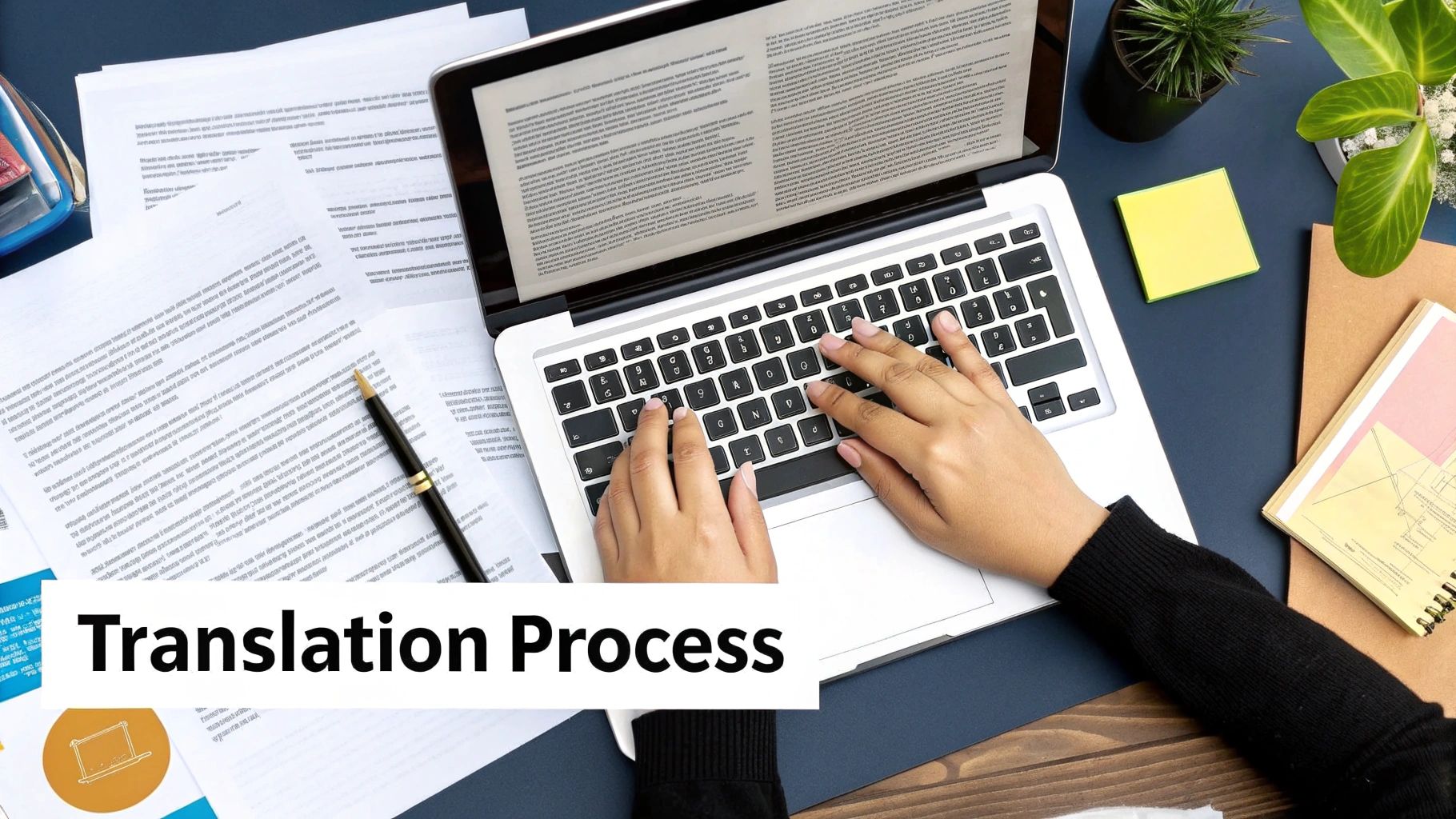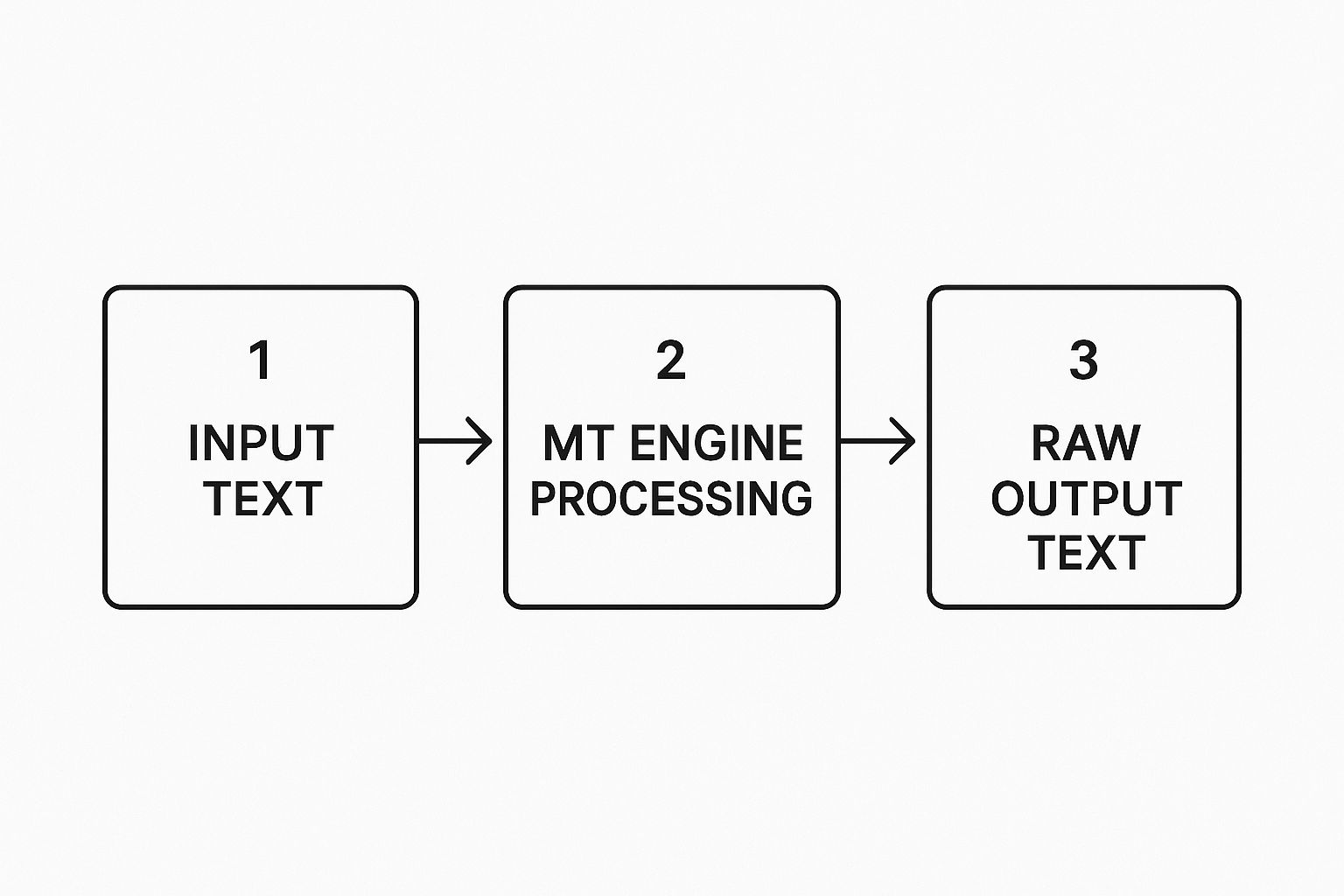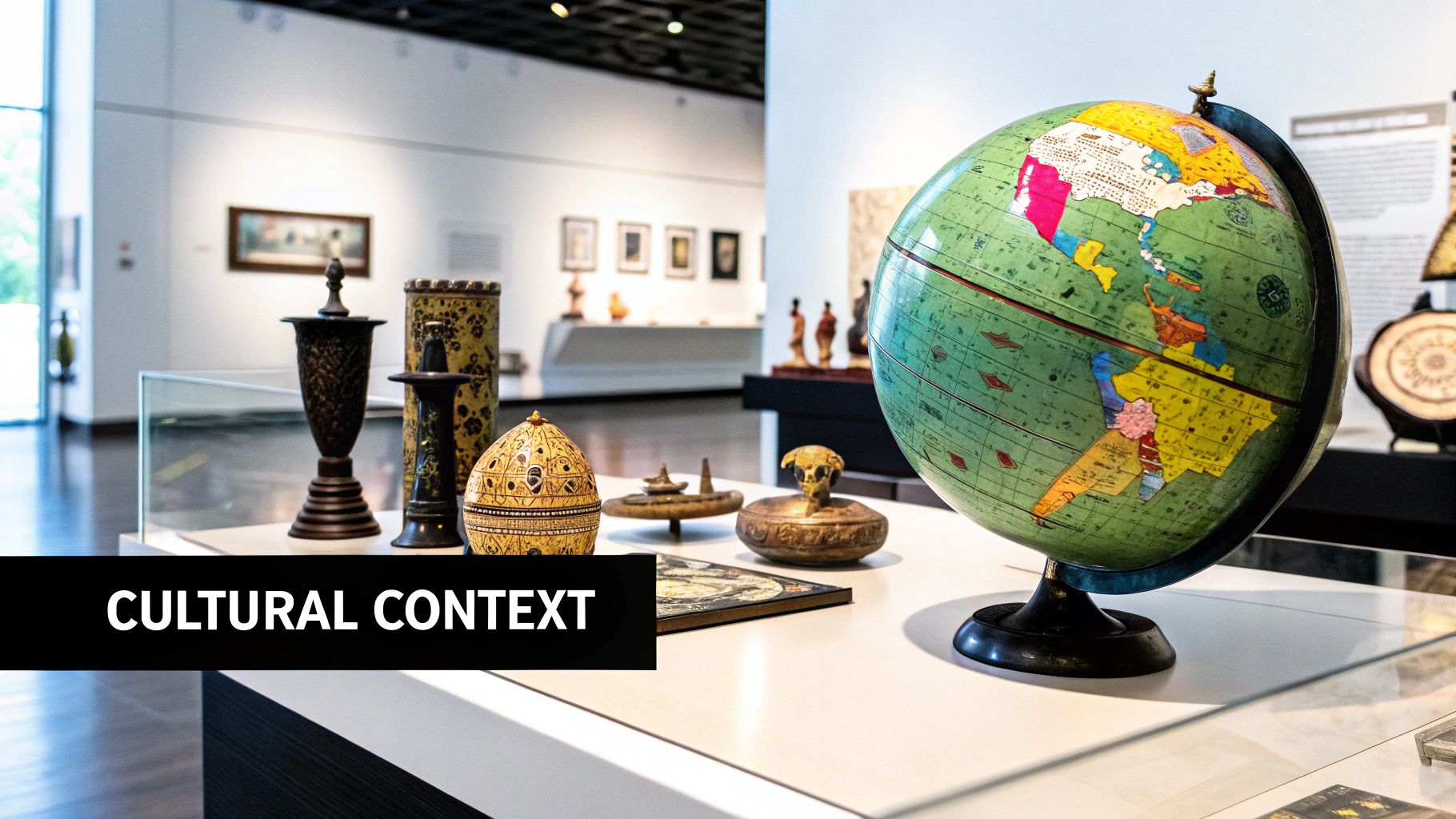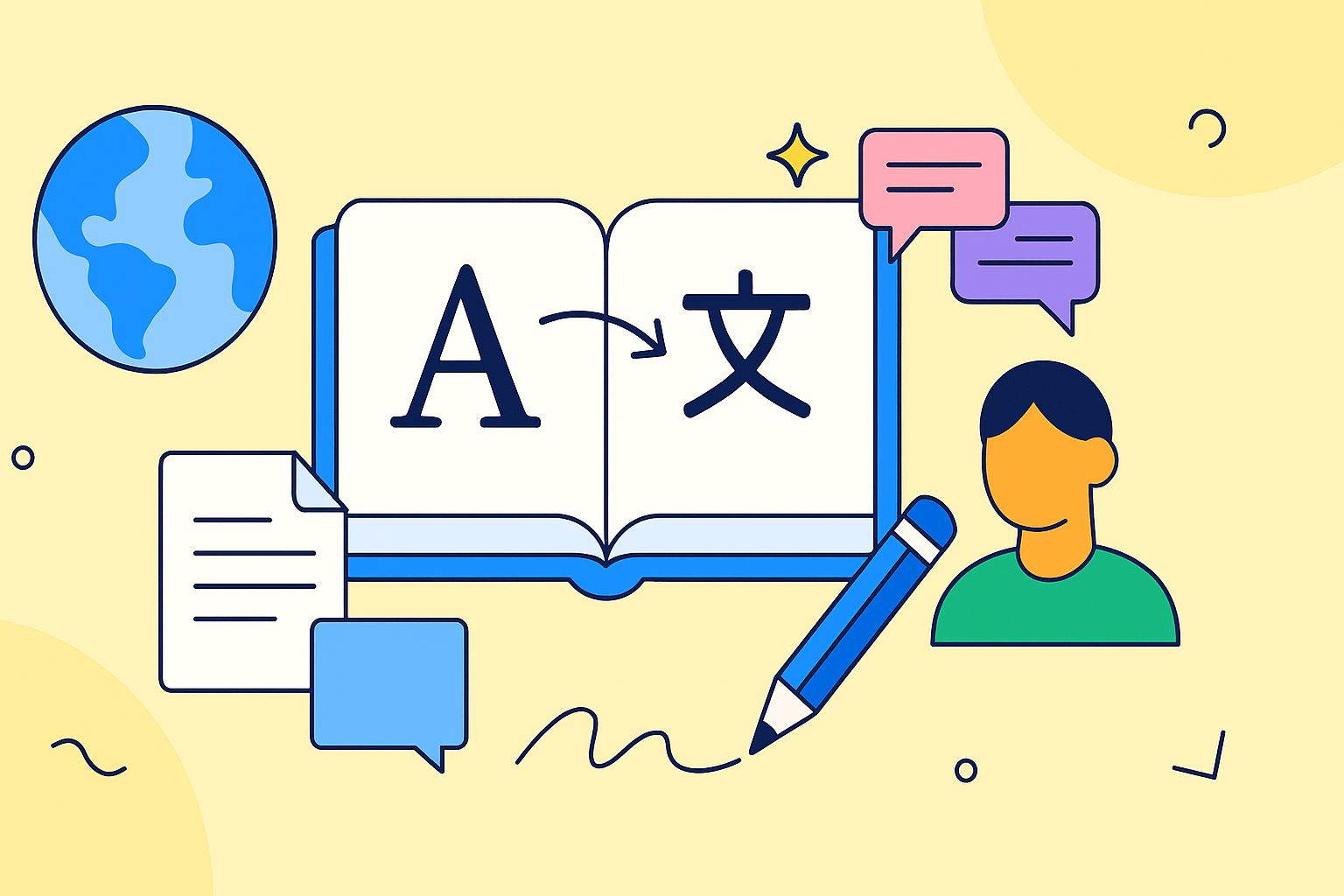At its core, translation is the craft of carrying a message from one language to another, making sure its meaning, tone, and intent all arrive in one piece.It’s the art of bridging communication gaps by converting written text from a source language to a target language.
Beyond Word-For-Word Exchanges

When we first think about translation, it’s easy to picture a simple, mechanical process of swapping one word for its equivalent in another language. But real, professional translation is so much more than that. It demands a sophisticated grasp of context, culture, and the original author’s intent to create something that feels completely natural to a native speaker.
Think of it like adapting a hit movie for a new country. You wouldn’t just translate the dialogue line-for-line. You’d have to rework the cultural references, the jokes, and the idioms so the story connects with the new audience. That’s the soul of effective translation.
The Human Element in Translation
A talented human translator wears many hats. They’re not just converting words; they’re acting as cultural interpreters, making sure the message is not only understood but also culturally fitting. This takes a deep, lived-in knowledge of both the source and target cultures.
For example, a clever marketing slogan that works wonders in English might fall flat—or even be offensive—if translated literally into Japanese.
True translation isn’t just about being bilingual; it’s about being bicultural. It requires the ability to step inside two different worlds and build a bridge between them.
The ultimate goal is to craft a text that doesn’t feel like a translation at all. It should read as if it were originally penned in the target language from the very beginning.
Distinguishing Key Concepts
To really understand what translation is, it helps to see what it isn’t. People often mix up translation with similar-sounding concepts like localization and transcreation. While they all involve adapting content for new audiences, they each have a different goal and approach.
Let’s break them down.
Translation vs Localization vs Transcreation at a Glance
| Concept | Primary Goal | Example |
|---|---|---|
| Translation | Faithfully render the original text’s meaning into another language. | Converting a technical user manual from German to English. |
| Localization | Adapt the entire product or content for a specific region. | Changing date formats (MM/DD/YYYY to DD/MM/YYYY), currency, and images for a UK audience. |
| Transcreation | Completely reimagine the core message to evoke the same emotional response. | Creating a new advertising slogan for a soft drink in China that captures the original’s feeling of “fun” using culturally relevant concepts. |
As you can see, translation is the foundational step. Localization builds on it by adapting the surrounding context, and transcreation takes the most creative license, focusing purely on the emotional impact. Knowing the difference helps you pick the right tool for the job.
Why Translation Is Essential for Modern Business
In a connected world, speaking your customer’s language isn’t just a polite gesture—it’s a powerful business move. Translation is the engine that drives global growth, building loyalty and opening doors to markets you couldn’t otherwise reach. It’s the difference between a generic announcement and a personal conversation.
The numbers don’t lie. Customers are far more likely to trust and buy from you when you speak their language. In fact, a whopping 76% of online shoppers prefer to see content in their native tongue, even if they’re fluent in English. That preference is so strong that 65% would rather deal with mediocre content in their language than top-notch content in a foreign one.
Build Trust, One Word at a Time
When a customer can read product details, find a support article, or get help in their own language, it creates an immediate sense of trust. It tells them you understand and care about their needs—a massive advantage in a crowded marketplace. This is why the most successful global brands don’t see translation as a cost, but as a core part of their strategy.
Think of it like this: an author’s brilliant novel will never find a new audience abroad if it isn’t adapted with cultural and linguistic care. That’s the core of effective global book publishing strategies. The same exact principle applies to any product or service hoping to make an impact internationally.
A study found that roughly 87% of B2C customers who don’t speak English said they wouldn’t buy from an English-only website. That single statistic reveals the staggering opportunity cost of a monolingual approach.
Unlock Your Global Potential
By breaking down the language barrier, your business can find new revenue streams and forge lasting relationships across the world. Bringing translation directly into your daily workflows, especially in customer support, is the key. For teams already on platforms like Jira Service Management, we’ve thought a lot about this. You can see how we integrate Google Translate for Jira and JSM to make it seamless.
At the end of the day, professional translation is far more than just swapping words. It’s a fundamental piece of any serious growth plan, with a direct line to customer satisfaction, market reach, and your bottom line.
Choosing Your Translation Method

Not every translation task is the same, so there’s no single “best” way to do it. The right approach really comes down to what you’re translating, how fast you need it, and what your budget looks like. You’ve basically got three main paths to choose from: human translation, machine translation, or a hybrid model that blends the two.
Getting a feel for the pros and cons of each one is key to building a smart multilingual strategy. Let’s break down what makes each option tick.
Human Translation: The Artisanal Approach
When your content absolutely has to connect with people on a creative or emotional level, nothing beats the touch of a skilled human translator. This is your go-to method for high-stakes material where every bit of nuance, cultural context, and brand voice is critical.
Think of it like getting a custom-built piece of furniture instead of one from a flat-pack box. A human expert doesn’t just translate words; they craft the text with care, making sure everything lands just right.
- Best for: Marketing copy, legal documents, literary works, and any customer-facing content that needs that personal, human feel.
- Strength: Unmatched quality, deep cultural accuracy, and genuine creativity.
- Consideration: This is usually the slowest and most expensive route. As you’d expect, quality work comes at a price, often based on specific prices for translation per word.
Machine Translation: The Engine of Speed
For high-volume, time-sensitive jobs, AI-powered machine translation (MT) is a total powerhouse. Today’s MT engines can chew through massive amounts of text in the blink of an eye, which is a game-changer for things like internal chats or sifting through big data sets.
The trade-off? MT can sometimes fumble the ball on subtle idioms or cultural specifics, which is something you have to weigh. If you’re looking at different options, especially for media, a good ultimate guide to AI video translation tools can give you a solid overview of what today’s tech can do.
By using machine translation, companies can translate content up to 3,000 times faster than with a human-only process. That’s a massive acceleration for global communication.
The Hybrid Model: Efficiency Meets Quality
So, what if you need the best of both worlds? The hybrid model offers a really practical middle ground. It kicks things off with a quick first draft from a machine translation engine, which a human linguist then reviews, edits, and polishes. This two-step process is often called Machine Translation Post-Editing (MTPE).
This approach is perfect when you need to be both efficient and accurate—think customer support tickets or knowledge base articles. It gives you a scalable, cost-effective way to get work done without throwing quality out the window.
How Professional Translation Gets Done
A top-notch translation isn’t just a one-and-done task; it’s the result of a carefully structured process. Think of it like a high-end kitchen: a whole team works together, managing every step to cook up a perfect result. This professional workflow is what turns raw, un-translated content into a polished and accurate final product that feels natural to the reader.
The process usually kicks off with a project manager, who plays the role of a head chef, overseeing the entire operation. They get the content ready, apply pre-approved glossaries to keep everything consistent, and coordinate the team of linguists. This setup ensures everyone is working from the same recipe.
The Core TEP Workflow
At the heart of any professional translation job is the TEP (Translation, Editing, and Proofreading) process. It’s a three-stage method that uses multiple experts to review the text, guaranteeing both accuracy and quality.
- Translation: The first linguist takes the source text and translates it into the target language, focusing on getting the meaning and tone just right.
- Editing: A second linguist then compares the translation against the original. They’re looking for any errors, ways to improve the flow, and ensuring the terminology is consistent.
- Proofreading: Finally, a proofreader gives the edited text one last polish, catching any sneaky typos or grammatical mistakes that might have slipped through.
This multi-layered approach is specifically designed to catch any and all errors before a translation ever makes it in front of an audience.
The infographic below shows a simplified version of this flow, often starting with machine translation as a first step.

As you can see, the raw text is fed into a machine engine, which creates a solid base for the human experts to then refine and perfect.
Managing the Process
Making sure all these steps happen smoothly requires some serious tools. Modern translation services lean heavily on advanced technologies to manage their workflows. For instance, some of the most sophisticated tools out there include AI Conversational IVR systems that can handle spoken language automatically.
For text-based projects, specialized platforms are absolutely essential. If you’re curious to see how these tools operate behind the scenes, you should check out our guide to a translation management system.
Quality Assurance (QA) is the final, crucial step. This involves both automated checks and a final human review to confirm the translation meets every single project requirement—from formatting to specific terminology—before it’s delivered.
Bringing Translation Concepts to Life
Theory is great, but how does all this translation talk work in the real world—say, inside a busy tool like Jira Service Management (JSM)? This is where the abstract ideas we’ve covered become practical, everyday solutions for global support teams.
A dedicated app like Issue Translation for JSM is built to apply these principles directly into your support workflow. It lets your team manage conversations in multiple languages without ever having to leave their service desk. Theory, meet practice.
A Practical Example in Jira
Picture this: a support agent in Germany gets a ticket from a customer in Japan. Instead of scrambling to find a Japanese-speaking colleague or copy-pasting into a separate tool, the system just handles it. The team can even decide how they want the translation to look, striking a balance between clarity and a smooth agent experience.
Here’s what an agent sees when a customer comment comes through.

This “bilingual mode” gives the agent the complete picture, showing both the original message and its AI-powered translation. This transparency is key—it helps them understand the customer’s issue precisely and, over time, even pick up on common phrases.
When you embed translation directly into the tools your team already relies on, you eliminate friction. Agents can get back to what they do best—solving problems—instead of getting bogged down by language barriers. The result? Faster resolutions and happier customers.
This whole setup is a perfect example of a hybrid approach in action. You get the speed and reliability of machine translation for the immediate need, but the agent provides that crucial human oversight. They can review, and if needed, even tweak the AI’s translation before replying to make sure the message is not only accurate but also carries the right company tone.
It’s the best of both worlds: pure speed backed by quality control.
The Rapidly Growing World of Language Services
The translation industry isn’t just some niche service anymore. Far from it. It’s a massive economic engine, and its growth is a direct reflection of how global our world has become. As businesses expand into new international markets and digital tools erase old borders, the demand for language services has simply exploded. It’s become an essential pillar of the modern economy.
This isn’t just a passing trend—we’re talking about a serious market expansion. The global language services industry is on track to hit around $75 billion by 2025, a huge jump from $53 billion in 2019. That’s a steady growth rate of nearly 6% every year, all thanks to the non-stop need for businesses to connect with customers, wherever they are. If you’re curious about the details, you can explore more insights on these key online trends.
The Economic Drivers of Growth
So, what’s pouring fuel on this fire? It really boils down to two major forces: digitalization and the explosion of global e-commerce. When companies sell their products and services online to a worldwide audience, clear and culturally-aware communication isn’t just a nice-to-have; it’s a critical factor for success.
- Global E-commerce: To even stand a chance, businesses have to translate everything. Product descriptions, marketing campaigns, customer support chats—you name it.
- Digital Content: The sheer amount of digital content out there is staggering. Websites, apps, social media, and knowledge bases all need constant translation and tweaking to stay relevant across different markets.
It’s important to grasp the difference between a simple, word-for-word translation and a deeper cultural adaptation. If you want to dig into this further, our guide to language localization offers a fantastic look at how to properly adapt your content for new audiences.
The Rise of Machine Translation
While all this growth is happening, AI and machine learning are shaking up the industry in a big way. The machine translation (MT) market, which was valued at $650 million in 2020, is predicted to rocket to $3 billion by 2027. This points to a powerful shift toward using technology for speed and scale.
But here’s the key takeaway: AI isn’t here to replace human experts. Instead, AI-powered tools are supercharging their abilities, making it possible to handle massive projects with much faster turnaround times. This blend of human skill and machine efficiency is what’s defining the future of translation for global businesses.
When you’re first dipping your toes into the world of translation, a few questions always seem to surface. One of the biggest debates? Pitting a human translator against a machine. The truth is, the best choice really comes down to what you’re trying to say, and who you’re saying it to.
For your most critical content—think marketing copy that needs to sing or legal documents where every word counts—a professional human translator is simply unmatched. They don’t just translate words; they translate culture, creativity, and the subtle context that machines often miss. This is how you make sure your message truly lands with your audience, both accurately and emotionally.
On the flip side, when you need to process a mountain of information at lightning speed, machine translation (MT) is your best friend. It’s the perfect tool for internal chats, sifting through massive amounts of data, or just getting the gist of a customer support ticket in a language you don’t speak.
The smartest play is often to combine the two. A common and highly effective workflow is to use machine translation to get a first draft on the page, and then bring in a human editor to polish and perfect it. This process, known as post-editing, gives you the best of both worlds: the speed of a machine and the quality assurance of a human expert.
Of course, businesses always want to know if these efforts are paying off. A solid automatic translation report for business can give you the hard data you need, showing clear efficiency gains and a tangible return on investment. At the end of the day, picking the right method is all about matching the right tool to the communication task at hand.
Ready to break down language barriers in your customer support? resolution Reichert Network Solutions GmbH offers a seamless solution. Try Issue Translation for JSM free on the Atlassian Marketplace and deliver effortless multilingual service today.
